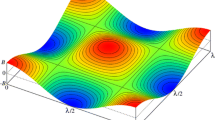Abstract
We study the heat transfer between elastic solids with randomly rough surfaces. We include both the heat transfer from the area of real contact, and the heat transfer between the surfaces in the non-contact regions. We apply a recently developed contact mechanics theory, which accounts for the hierarchical nature of the contact between solids with roughness on many different length scales. For elastic contact, at the highest (atomic) resolution the area of real contact typically consists of atomic (nanometer) sized regions, and we discuss the implications of this for the heat transfer. For solids with very smooth surfaces, as is typical in many modern engineering applications, the interfacial separation in the non-contact regions will be very small, and for this case we show the importance of the radiative heat transfer associated with the evanescent electromagnetic waves which exist outside of all bodies.
Similar content being viewed by others
References
B.N.J. Persson, J. Phys.: Condens. Matter 18, 7789 (2006)
For a review of thermal joint resistance models for rough surfaces, see, e.g., M. Bahrami, J.R. Culham, M.M. Yovanovich, G.E. Schneider, Appl. Mech. Rev. 59, 1 (2006)
J.A. Greenwood, J.B.P. Williamson, Proc. R. Soc. London, Ser. A 295, 300 (1966)
A.W. Bush, R.D. Gibson, T.R. Thomas, Wear 35, 87 (1975)
C. Campana, M.H. Müser, M.O. Robbins, J. Phys.: Condens. Matter 20, 354013 (2008)
G. Carbone, F. Bottiglione, J. Mech. Phys. Solids 56, 2555 (2008)
See also Appendix A in B.N.J. Persson, J. Phys.: Condens. Matter 20, 395006 (2008)
B.N.J. Persson, J. Phys.: Condens. Matter 20, 312001 (2008)
B.N.J. Persson, F. Bucher, B. Chiaia, Phys. Rev. B 65, 184106 (2002)
B.N.J. Persson, J. Chem. Phys. 115, 3840 (2001)
B.N.J. Persson, Eur. Phys. J. E 8, 385 (2002)
B.N.J. Persson, Phys. Rev. Lett. 99, 125502 (2007)
C. Yang, B.N.J. Persson, J. Phys.: Condens. Matter 20, 215214 (2008)
B.N.J. Persson, Surf. Sci. Rep. 61, 201 (2006)
B.N.J. Persson, C. Yang, J. Phys.: Condens. Matter 20, 315011 (2008)
M. Borri-Brunetto, B. Chiaia, M. Ciavarella, Comput. Methods Appl. Mech. Eng. 190, 6053 (2001)
L. Pei, S. Hyun, J.F. Molinari, M.O. Robbins, J. Mech. Phys. Solids 53, 2385 (2005)
B.N.J. Persson, O. Albohr, U. Tartaglino, A.I. Volokitin, E. Tosatti, J. Phys.: Condens. Matter 17, R1 (2005)
B.N.J. Persson, Sliding Friction: Physical Principles and Applications, 2nd edition (Springer, Heidelberg, 2000)
C. Yang, U. Tartaglino, B.N.J. Persson, Eur. Phys. J. E 19, 47 (2006)
S. Hyun, L. Pei, J.F. Molinarie, M.O. Robbins, Phys. Rev. E 70, 026117 (2004)
Y.F. Mo, K.T. Turner, I. Szlufarska, Nature 457, 1116 (2009)
J.A. Greenwood, Brit. J. Appl. Phys. 17, 1621 (1966)
J.R. Barber, Proc. R. Soc. London, Ser. A 459, 53 (2003)
J.F. Archard, Wear 2, 438 (1959)
D. Pires, B. Gotsmann, F. Porro, D. Wiesmann, U. Duerig, A. Knoll, Langmuir 25, 5141 (2009)
A.I. Volokitin, B.N.J. Persson, Rev. Mod. Phys. 79, 1291 (2007)
K. Joulain, J.P. Mulet, F. Marquier, R. Carminati, J.J. Greffet, Surf. Sci. Rep. 57, 59 (2005)
D. Segal, A. Nitzan, Chem. Phys. 268, 315 (2001)
D. Segal, A. Nitzan, Chem. Phys. 281, 235 (2002)
Y. Selzer, M.A. Cabassi, T.S. Mayer, D.L. Allara, Nanotechnology 15, S483 (2004)
V. Popov, Kontaktmechanik und Reibung (Springer, Heidelberg, 2009)
M. Bahrami, J.R. Culham, M.M. Yovanovich, Proceedings of the International Mechanical Engineering Congress and Exhibition (IMECE), ASME paper 44097 (Washington, 2003)
D.Z.A. Chen, R. Hamam, M. Soljacic, J.D. Joannopoulos, G. Chen, Appl. Phys. Lett. 90, 181921 (2007)
M. Bahrami, M.M. Yovanovich, J.R. Culham, J. Thermophys. Heat Transfer 18, 326 (2004)
B.N.J. Persson, J. Phys.: Condens. Matter 20, 315007 (2008)
K.L. Johnson, Contact Mechanics (Cambridge University Press, Cambridge, 1985)
L. Shi, A. Majumdar, J. Heat Transfer 124, 329 (2002)
C. Yang, B.N.J. Persson, J. Israelachvili, K. Rosenberg, Eur. Phys. Lett. 84, 46004 (2008)
In ref. PSSR we used $A_{\ab{pl}}/A^0_{\ab{pl}}$ instead of $(A_{\ab{pl}}/A^0_{\ab{pl}})^6$ in the expression for $\bar{C}$, but we have found that the latter (more rapid) cut-off, gives better results: The contact area as a function of magnification, for elastic contact with the latter $\bar{C}$, gives virtually the same result as the calculated (total) contact area using the elastoplastic contact mechanics theory and the original surface roughness power spectrum
B.S. Oh, Y.N. Kim, N.J. Kim, H.Y. Moon, H.W. Park, Tire Sci. Technol. 23, 11 (1995)
H. Yüncü, Heat Mass Transfer 43, 1 (2006)
M.M. Yavanovich, AIAA-86-1164, presented at 16th Thermo Physics Conference (1981), Palo Alto, CA, USA
As an example, using AFM we have measured the height profile of a polished steel surface over a $10\un{\mu m} \times 10$ m surface area with the resolution $a = 20$nm. From the numerical data we calculated the root-mean-square (rms) roughness $h_{\ab{rms}} \approx 0.1$ m and the rms slope $s \approx 0.6$. Increasing the lateral resolution would increase the slope further since the slope is mainly determined by the short-wavelength roughness
It may be argued that, due to plastic deformation, the slope in (eq:71) should be calculated including only the roughness with wavelength above some cut-off length. However, no discussion of this point was presented in ref. Yovanovich
L.D. Landau, E.M. Lifshitz, Fluid Mechanics (Pergamon Press, Oxford, 1959)
J. Mc Allen, A.M. Cuitino, V. Sernas, Finite Elements Anal. Design 23, 265 (1996)
C.O. Popiel, L. Boguslawski, Int. J. Heat Mass Transfer 18, 170 (1975)
Author information
Authors and Affiliations
Corresponding author
Rights and permissions
About this article
Cite this article
Persson, B.N.J., Lorenz, B. & Volokitin, A.I. Heat transfer between elastic solids with randomly rough surfaces. Eur. Phys. J. E 31, 3–24 (2010). https://doi.org/10.1140/epje/i2010-10543-1
Received:
Revised:
Accepted:
Published:
Issue Date:
DOI: https://doi.org/10.1140/epje/i2010-10543-1



